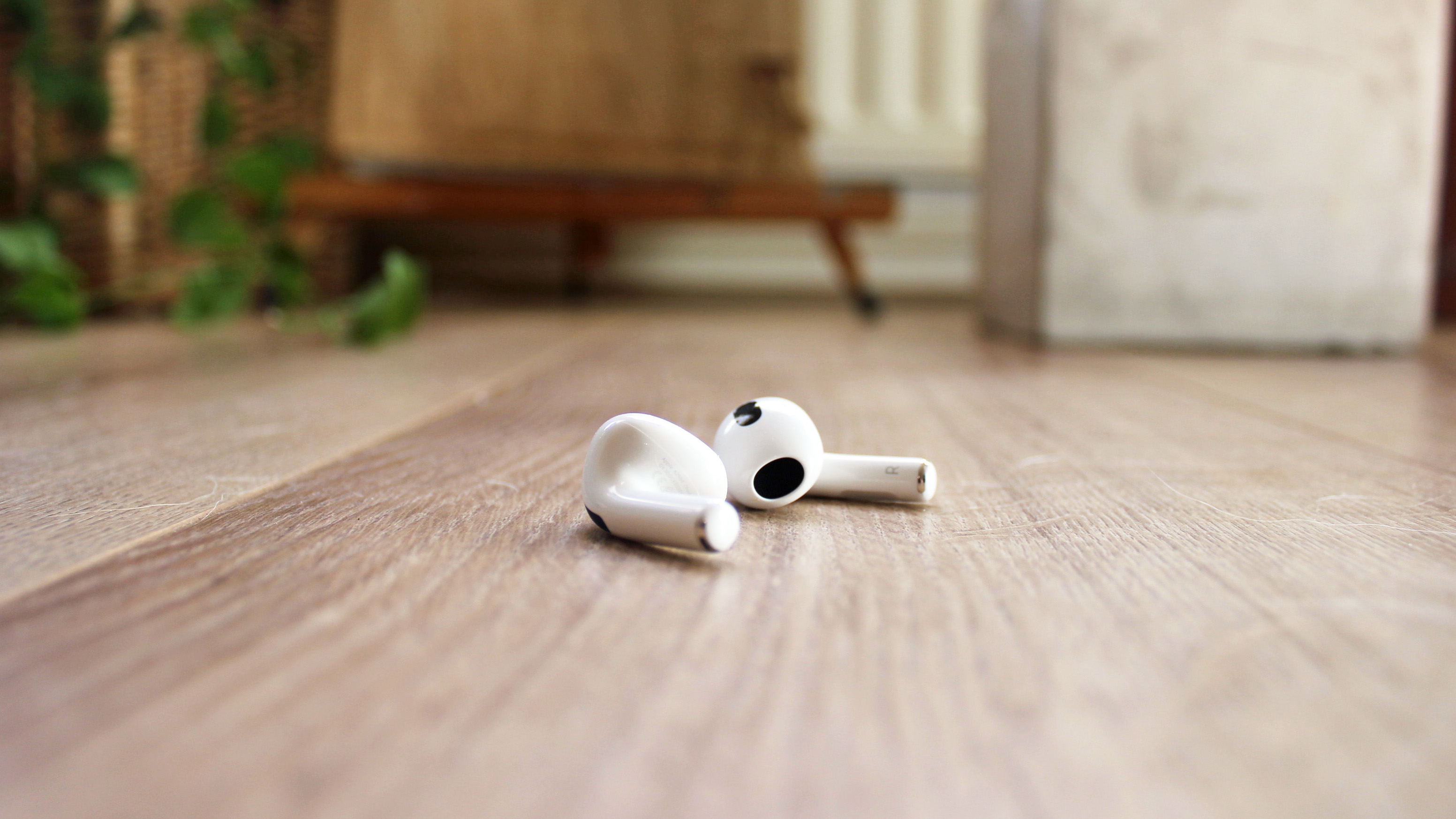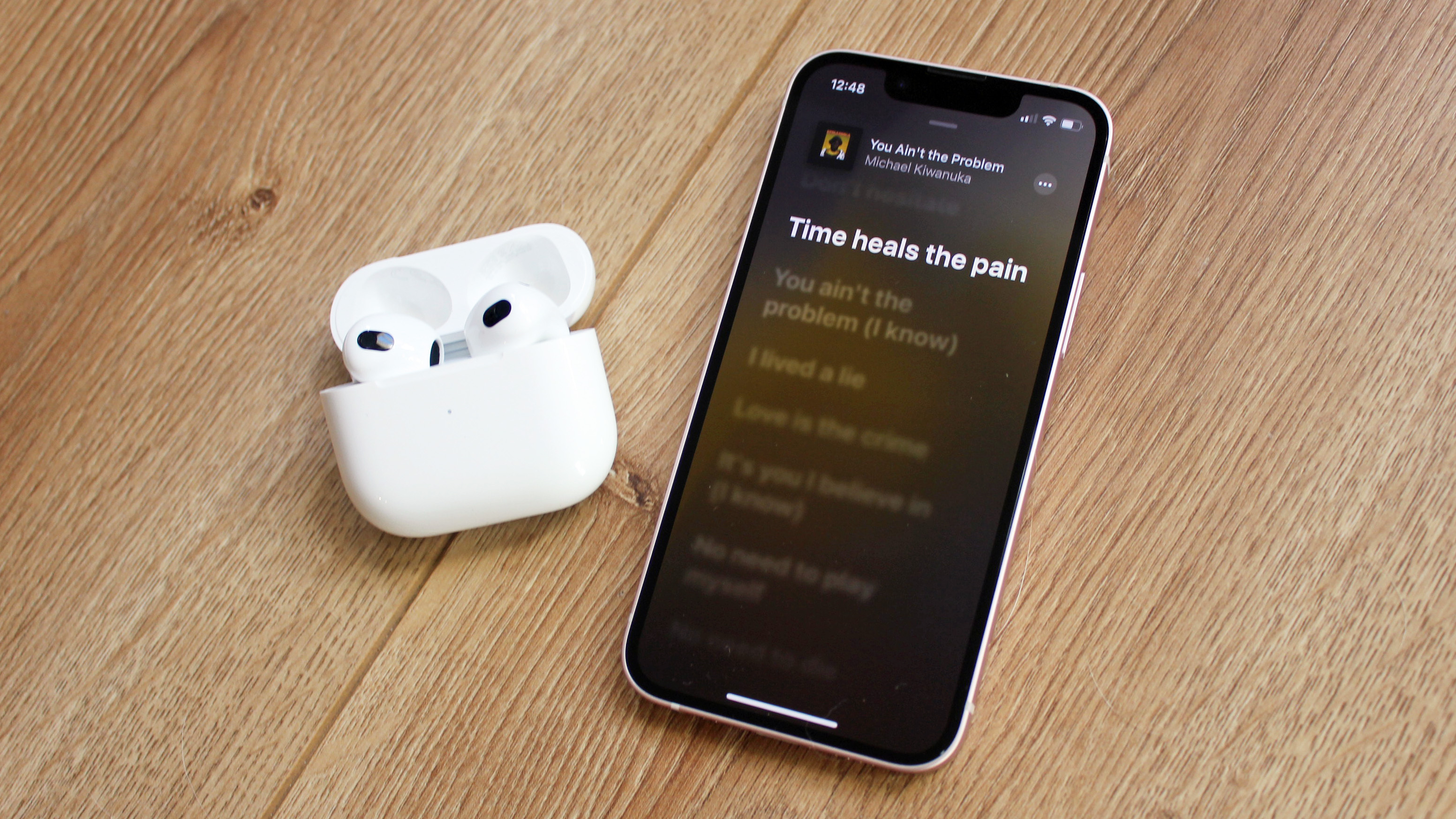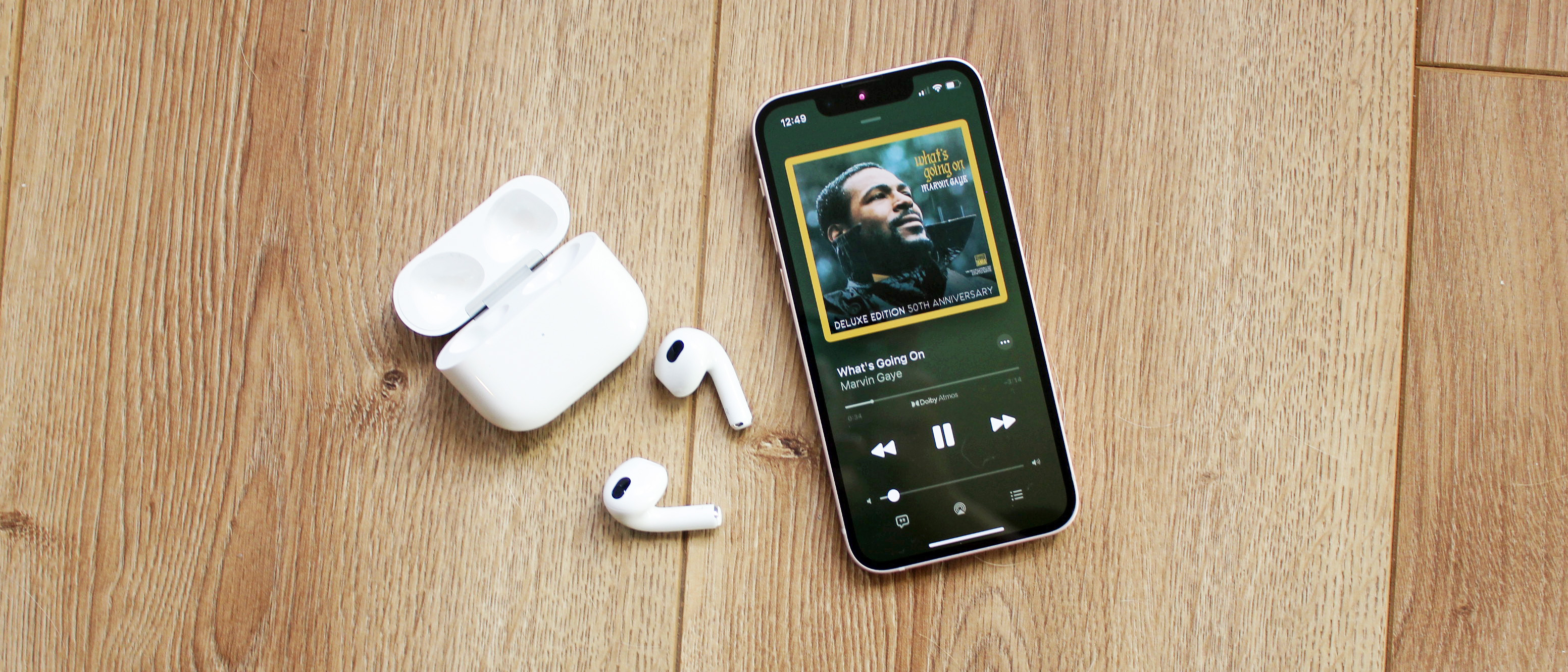TechRadar Verdict
The Apple AirPods (3rd generation) represent a big step up from their predecessors in terms of audio performance, connectivity, and design – and while they come with a price increase, we think they’re a worthy upgrade if you have the older AirPods. However, we wouldn’t necessarily recommend them for Android users. The AirPods 3 are unsurprisingly optimized for use within the wider Apple ecosystem, so Android users miss out on a lot of the extra features that set them apart from other true wireless earbuds on the market, and the lack of noise cancellation means they aren’t the most high-spec earbuds at this price.
Pros
- +
Impressive spatial audio
- +
Easy to use
- +
Comfortable, subtle design
Cons
- -
No active noise cancellation
- -
No interchangeable eartips
- -
Battery life could be longer
Why you can trust TechRadar
Two-minute review
The Apple AirPods 3 are the latest true wireless earbuds in Apple's line-up of AirPods buds. They come with a host of updates that make them a worthy upgrade from their predecessors, the AirPods 2.
However, they're no longer the newest buds from Apple if you also count the Pro range. That title now goes to the recently launched AirPods Pro 2. These are the brand's latest noise-cancelling earbuds that are a significant upgrade over the AirPods Pro in terms of both functionality and audio performance.
As you might expect, however, both Pro models are more expensive than the AirPods 3 we're reviewing here, which are still pricey at $179 / £169 / AU$279, but more affordable if you don't mind sacrificing noise cancellation and some of the Pro and Pro 2's high-end features.
A refreshed design retains the general look of the original AirPods, but introduces shorter stems and contoured housings, which feel more comfortable to wear than the previous model. Those stems now feature touch capacitive force sensors, which you can squeeze to control your music playback and accept and end phone calls.
Their lightweight build and IPX4 water-resistance rating makes the AirPods 3 suitable for use while working out; and while they don’t feel as secure as earbuds such as the Powerbeats Pro, they were able to withstand a gentle jog without falling out of our ears.
While these new design features are welcome, we were most impressed by the improvements Apple has made to the audio performance of these earbuds. New drivers and amplifiers provide a well-balanced sound, while Spatial Audio support promises to make the music you love sound more immersive than ever before.
Whether you’re listening to tracks mixed in Dolby Atmos, or regular stereo tracks that have been upscaled using the Spatial Audio technology, the result is breathtaking. The experience is only heightened when you use the AirPods 3 to watch films. You don’t need an iPhone to use Spatial Audio, either; as long as you have a Dolby Atmos-enabled phone and access to an app that supports the feature, you’re good to go.

However, you shouldn’t mistake the AirPods 3 for audiophile-grade in-ear headphones. Support for hi-res audio is lacking, and the treble frequencies can be harsh at times – a problem that was evident with the second-generation AirPods.
Calls sound clear thanks to a new acoustic mesh that covers the AirPods’ outward-facing microphones and support for the AAC-ELD codec.
The battery life of the AirPods 3 has also been improved compared to the AirPods 2, although the difference is negligible if you’re using them with Spatial Audio enabled. Have that particular feature switched off, however, and you can expect up to 30 hours of playback, which is more than enough to get you through a week of commuting.

Rather predictably, connectivity is very good indeed – as long as you’ve already bought into the wider Apple ecosystem. Pairing the buds with an iPhone 13 mini was as easy as opening the wireless charging case and tapping the prompt that appeared on our screen.
Owners of iOS 15 devices also get some extra connectivity features from the AirPods (3rd generation), which include hands-free Hey Siri activation, Announce Notifications, Audio Sharing, Group Facetime with Spatial Audio, and integration with Apple’s Find My network.
These extra quality of life features are what differentiate the AirPods 3 from rival models – and they make the exclusion of active noise cancellation easier to swallow.
Unfortunately, if you don’t have access to an iOS device, you lose out on all of these features. As such, we wouldn’t recommend the AirPods 3 for anyone who isn’t already invested in Apple’s line of smartphones, laptops, tablets and smartwatches.
But, if you love all things Apple and want a pair of the best wireless earbuds that ‘just work’, then the AirPods 3 are a fantastic choice, and a huge step up from the AirPods 2.
Apple AirPods (3rd generation) price and release date
- Available now
- $179 / £169 / AU$279
- Cheaper than the AirPods Pro
The Apple AirPods 3 (2021) cost $179 / £169 / AU$279 and are available to buy now. They first went on sale on October 26, 2021.
That’s cheaper than the noise-cancelling AirPods Pro, and a little pricier than the second-gen AirPods, which cost $159 / £159 / AU$249 at their 2019 launch with the standard charging case. If you opted for the wireless charging case, you’d have to pay $199 / £199 / AU$319. The wireless charging case comes as standard with the AirPods 3.
The price of the second-gen AirPods has since been reduced. Apple is now selling them for $129 / £119 / AU$219, and discounts are often available.

Compared to other true wireless earbuds on the market, the AirPods (3rd generation) are cheaper than many of our top picks, such as the Sony WF-1000XM4 and the NuraTrue earbuds. However, earbuds at this price tend to come with active noise cancellation, which the AirPods 3 are lacking.
There are plenty of cheaper wireless earbuds available to buy, too. Earbuds such as the Cambridge Audio Melomania 1 Plus and the Lypertek PurePlay Z3 2.0 offer outstanding audio performances for their prices, and models such as the Beats Studio Buds even come with active noise cancellation for $149.99 / £129.99 / AU$199.95.

Design
- Shorter stems than AirPods 2
- New contoured housings
- Touch-sensitive controls
In terms of design, the AirPods 3 don't deviate too far from previous AirPods models, with an all-white minimalist aesthetic, protruding stems, and gently curved lines.
With shorter stems and softly contoured housings, the AirPods 3 look more like the AirPods Pro than the second-gen AirPods, giving them a more streamlined, elegant look.
Those stems feature touch-capacitive force sensors – just like the ones found on the AirPods Pro – that allow you to control your music playback with a squeeze of the stem. You can also squeeze the stem to accept or end calls.

We found the controls to be super-responsive, and we liked the little ‘click’ sound that lets you know that your touch has been registered. As with the AirPods Pro, some haptic feedback would also be welcome – a slight vibration from the buds themselves rather than a click, but that isn’t a dealbreaker by any means.
It’s a shame there’s no way to control the volume of your music via the buds themselves, perhaps by sliding your finger up and down the stems. For that, you’ll need to ask Siri, or dig your phone out of your pocket.

Unlike the AirPods Pro, there are no interchangeable eartips. Retaining the semi-open design of the second-gen AirPods will appeal to those who don’t like the feeling of earbuds being pushed into their ear canals, but it does mean that sound isolation isn’t the best.
You’ll be able to hear pretty much everything that’s going on around you while using the AirPods 3, plus there’s a degree of sound leakage, too – something to consider if you’re using them in a crowded setting and don’t want everyone listening in on your music.
To mitigate the audio loss that comes with a semi-open design, the housings have been shaped to funnel sound straight into your ears – and it appears to be pretty effective.

The AirPods 3 feel very comfortable, something that’s helped by the earbuds’ light weight. At 4.28g each, the AirPods 3 won’t make you feel like you’ve got two lumps of lead shoved in your ears, and they shouldn’t irritate smaller ears thanks to their smooth, contoured shape.
We’re not sure how secure they feel, though. We took them out on a light jog, and while the AirPods didn’t fall out of our ears, we wouldn’t be willing to bet our lives on them staying put through a more vigorous workout. If you’re concerned about losing an earbud, we’d recommend opting for a pair with built-in earfins, or a pair of neckbuds that have the added security of a cable.

Speaking of exercise, the AirPods 3 are fully equipped to handle a little sweat through workout or being caught out in the rain, thanks to an IPX4 rating. That rating applies to the case, too.
The charging case itself is much squatter than the case accompanying the AirPods 2. It more closely resembles the AirPods Pro charging case, with a light, compact build and a flip-top lid that’s easy to open one-handed.

Opening the case causes a small LED on its front to light up: green, if the AirPods are fully charged; amber, if less than one full charge remains. This light will also flash white if the AirPods are ready to pair with one of your devices.
At the bottom of the charging case is a Lightning port, although you can top up the battery using a Qi-certified charging mat, or an Apple MagSafe charger. You get a USB-C to Lighning cable included in the box, but you’ll have to source your own plug.
Overall, the design of the AirPods 3 represents a big improvement over their predecessors. They’re slicker, more understated, and more robust, too.

Audio performance
- Spatial Audio support
- Well balanced sound
- Good sound quality for calls
The AirPods 3 feel like a significant step up from their predecessors for audio quality. They come with new custom-made, low-distortion drivers and high dynamic range amplifiers.The latter are supposed to deliver “powerful bass with crisp, clean high frequencies”, according to Apple.
The new earbuds certainly do better at conveying bass frequencies than the AirPods 2, and they offer a more powerful, warmer sound. These aren’t audiophile in-ear headphones by any means, but they’re a perfectly enjoyable listen, whether you’re playing music or podcasts.
Thanks to support for Adaptive EQ (first seen on the AirPods Pro), the AirPods 3 should be somewhat tailored to your ears. This technology tunes the sound of the earbuds in real-time, based on how they fit in your ear. According to Apple, an inward-facing microphone monitors for sound, and then the computational audio that powers the Adaptive EQ feature tunes the low and mid frequencies "to account for what may be lost due to variances in fit".

The AirPods 3 come with another trick up their sleeves: Spatial Audio support. Apple’s Spatial Audio technology takes 5.1, 7.1 and Dolby Atmos content and applies directional audio filters, placing sound in a 3D sphere. This makes it feel more immersive; as if the audio is coming at you from every angle.
Until now, this feature only worked with the AirPods Pro and the AirPods Max, since it relies on their built-in accelerometers and gyroscopes to track the position of your head and ensure the sound is coming from the right direction.
The same tech is at play in the AirPods 3, and the effect is super-impressive. We started by listening to a Dolby Atmos mix of The Doors’ Riders On The Storm on Apple Music.

As the band members talk to each other at the start of the track, the spatial audio positioning of their voices makes it feel as though you’re in the room with them.
When the drummer counts in, we hear the sound of a storm breaking. It feels as though rain is falling overhead, with rolling thunder panning from right to left.
The positioning of the instruments in space is subtle, but effective. To our right is the mellow guitar, while the organ chugs away on our left. At the back of the soundstage, the bass and drums provide the rhythmic backbone of the track, while Jim Morrison’s dulcet vocal reverberates right at the front.
Each instrument has its own space to shine, and the bass, mid, and treble frequencies feel well balanced. It isn’t the most detailed or rhythmically tight rendition we’ve heard of this particular track, but the AirPods 3 do a great job of conveying a sense of space, and the positioning of the different instruments in a virtual sphere.

Michael Kiwanuka’s You Ain’t The Problem is equally impressive in this regard – although we did find the thrashing electric guitar lines to be way too prominent in the mix, to the point that the hooky ‘la-la-la’ section at the beginning of the song sounded subdued. The AirPods 3 seem to share the same issues with treble harshness as their predecessors, and busier tracks can sound muddy at times.
Classical music fares very well in Spatial Audio. Listening to Saint Saëns’ Danse Macabre, and each instrument truly sings, from the booming tubas to the playful glockenspiel melodies. Devilish violin motifs and gentle woodwind sound detailed, and the AirPods 3 handle the rhythmic changes reasonably well for a pair of earbuds at this price.
Listening without Spatial Audio enabled (you can switch this off by heading to the Control Center of your iPhone and holding down the volume slider), and the separation between different instruments is less impressive. Nevertheless, the soundstage is still pretty well balanced and pleasant to listen to.

Codec support is limited – you’ve just got SBC and AAC. This means the AirPods 3 can’t handle hi-res audio streaming. It’s a shame, since Apple Music offers Lossless audio – and while Bluetooth hasn’t had the bandwidth necessary for truly lossless music streaming in the past, recent innovations such as Qualcomm aptX Lossless have made it possible.
Spatial Audio for music works well, but the technology’s best application is for film. The AirPods 3 are more than capable of handling complicated Dolby Atmos soundtracks. Watching Blush, an animated short on Apple TV Plus, we felt as though rockets were really zooming past our head.
As for phone calls, an acoustic mesh covers the outer beamforming microphones, which is designed to reduce the sound of wind and make your voice sound clear. The AirPods 3 also support the AAC-ELD codec, which Apple says will deliver "Full HD voice quality" – whatever that means. When making calls using the AirPods 3, recipients said that our voice sounded clear, and they didn’t notice any background noise.

Battery life
- 30-hour max battery life
- 24 hours with Spatial Audio on
- Wireless charging case
The AirPods 3 come with improved battery life… sort of. While the 2019 AirPods offered 24 hours of playback in total (that's about five hours from the earbuds and a further 19 hours from the charging case), the new AirPods 3 offer a 30-hour max battery life.
Apple says you get up to six hours of listening time or up to four hours of talk time from the buds themselves, with four additional charges from the case. If you're in a hurry, a quick five-minute charge will give you about an hour of playback. As with the AirPods Pro, the AirPods 3 come with a wireless charging case as standard, which is compatible with Apple's MagSafe ecosystem.
That all sounds good, but the onboard battery life does drop to five hours if you have Spatial Audio enabled – which is the same playback time as the older AirPods. Since Spatial Audio is one of the main reasons to buy the AirPods 3 over the AirPods 2, you’re not really getting the benefit of the longer battery life.

Connectivity
- Work best with iOS devices
- Super fast pairing
- Extra features for iOS 15
Not surprisingly, the AirPods 3 are optimized for use with Apple devices, with a one-touch setup that automatically pairs the buds with your iPhone, iPad, Mac, or MacBook.
Audio Sharing means you can also share the audio stream between two sets of AirPods, AirPods Pro, or AirPods Max, while using your iPhone, iPad, iPod touch, or Apple TV – pretty handy if you want to share your music without sharing your friends' grubby earbuds. We found this feature worked fairly seamlessly, although we did notice a drop in volume when sharing music with a friend.
There's also a new skin-detect sensor that tells the AirPods 3 if the buds are actually in your ear, as opposed to on a table or inside your pocket. So, if they're not in your ear, music playback will be paused, which will presumably spare you some precious battery life.

As with the 2019 AirPods, you can summon Apple's voice assistant simply by saying 'Hey Siri'. We found the microphones were adept at picking up our voice.
If you have an Apple device that runs iOS 15, you'll get access to a few extra features with the third-gen AirPods, including Spatial Audio and dynamic head tracking in Group FaceTime calls, alongside integration with the Find My network. You'll also get access to the Announce Notifications feature, which allows Siri to read you time-sensitive updates from apps such as Messages, Reminders, and Calendar – it’s a handy feature if you like to keep up with your notifications without being glued to your phone.
Should I buy the Apple AirPods (3rd generation)?

Buy them if...
You want to experience Spatial Audio
These are the cheapest AirPods to support Spatial Audio, and it’s well worth trying with music and film.
You have an iPhone
Features like Audio Sharing, Announce Notifications, and integration with the Find My network make the AirPods 3 the perfect earbuds for using with iPhone.
You want wireless charging
Wireless charging comes as standard with the AirPods (3rd generation), and they’re also MagSafe-compatible.
Don't buy them if...
You need active noise cancellation
The AirPods 3 don’t come with ANC, and the semi-open design means the passive noise cancellation isn’t particularly good - check out the AirPods Pro if that’s a dealbreaker.
You want hi-res audio support
With support for only the SBC and AAC codecs, you won’t be able to enjoy hi-res audio with the AirPods 3.
You have the AirPods Pro already
As much as we like the AirPods 3, the AirPods Pro are still the most high-spec true wireless earbuds from Apple.
- Looking for more? Read our guide to the best true wireless earbuds you can buy today
Olivia was previously TechRadar's Senior Editor - Home Entertainment, covering everything from headphones to TVs. Based in London, she's a popular music graduate who worked in the music industry before finding her calling in journalism. She's previously been interviewed on BBC Radio 5 Live on the subject of multi-room audio, chaired panel discussions on diversity in music festival lineups, and her bylines include T3, Stereoboard, What to Watch, Top Ten Reviews, Creative Bloq, and Croco Magazine. Olivia now has a career in PR.

